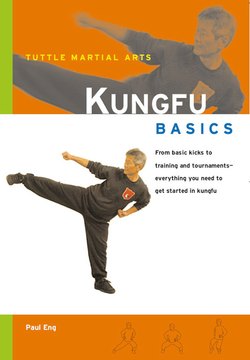Читать книгу Kungfu Basics - Paul Eng - Страница 10
На сайте Литреса книга снята с продажи.
ОглавлениеTHE STUDY AND PRACTICE of kungfu has always had strong spiritual, moral, and ethical components. Why? How did it become more than a collection of fighting techniques? The reasons have to do with the influences of Buddhism, Taoism, and Confucianism in the context of Chinese culture. Although today the ethical elements of kungfu have been somewhat obscured by mass marketing and commercialism—that is, by the need of kungfu masters and schools to survive in a commercial world—nevertheless, they do survive and perhaps explain kungfu’s continuing appeal to modern generations, both Eastern and Western. Understanding the three strongest philosophical roots of kungfu will give a profound and essential dimension to your practice.
Buddhism
The Buddha was a man who found a way to reduce personal suffering through self-awareness. He emphasized that the only way to achieve true, enduring happiness was through one’s own concentrated effort, and he summarized how one should work toward this goal in his “eightfold path,” which is: right understanding, right aspirations, right action, right speech, right livelihood, right effort, right concentration, and right mindfulness. Thus, the life Buddha encouraged his followers to lead was not a passive one, but rather one in which every thought and deed was focused in one direction: toward eliminating suffering. In the course of his own search, Buddha found that stringent ascetic practices—punishing the physical body—did not bring him closer to enlightenment. Indeed, on the contrary, a healthy physical body enhanced spiritual practices, enabling longer and more focused meditation. This explains the first introduction of physical exercises in the Shaolin Temple; it perhaps also explains why, traditionally, masters of the Chinese martial arts have also been masters of the healing arts.
Buddha’s teaching of compassion translates into nonviolence and the use of power only as a last resort. Thus, from Buddhism, came the understanding that violence could not end violence and that any action done in anger can only create more anger. Real victory, the Buddhist scriptures suggest, lies in eliminating animosity and hatred. If you can transform and/or eliminate your opponent’s desire to fight, then you achieve ultimate self-defense.
Taoism
Taoism, or the philosophy of the Tao, is expressed most famously in the Tao Te Ching, or Dao De Jing, a collection of terse, enigmatic observations on nature, ostensibly written by the philosopher Lao-tzu in the sixth century B. C.
Taoism teaches that the entire universe is animated by a vital energy that can be felt and only roughly defined in words as the “Tao.” Any movement in harmony with nature, or with the Tao, flows freely, without resistance. Thus, human happiness, peace, contentment, success, and immortality all lie in coming into perfect harmony with the Tao of nature. By eliminating the fears, desires, and judgment of personal ego, you will, in some sense, be carried away by the Tao—“acting without intention” and “winning without a fight.”
When Taoist martial artists looked to nature, they came away influenced in three specific and very important ways. First, the masters modeled their fighting techniques on wild animals, such as the tiger, monkey, and praying mantis. Second, the paradox of the power of softness, yielding, and submissiveness influenced many of their approaches to strategy in fighting. That is, there was and is much emphasis on sensing your opponent’s intention, receiving the power of a punch or kick “submissively,” and then turning that power—your opponent’s own strength—against him or her. Developing sensitivity and intuitive understanding of an opponent is a critical part of martial arts study and practice. Finally, in their study of the subtle energy of the universal Tao, the Taoist martial artists also developed understanding of human internal energy and the means to cultivate, circulate, and use it, as applied in the “soft” or internal aspects of the martial arts.
Confucianism
Confucius, who lived at about the same time as Lao-tzu, focused his life and philosophy on how to achieve harmony in society. He believed that the key was maintaining appropriate relationships between people, beginning with the core relationships of a family between father and son and husband and wife. If these relationships were strong, then stability and harmony would resonate throughout the nation—to all on earth under heaven. The eight basic virtues he taught were: loyalty, trust, filial piety, responsibility for those under you, courtesy, honor, humility, and sense of personal shame.
From Confucius, then, comes the strong family structure of kungfu societies: the loyalty to fellow martial artists within your organization and the reverence for present teachers and past generations of masters. From his teachings, also, perhaps comes the respect for the art itself, as a living entity that students must honor, cherish, and perpetuate. This strong moral structure has carried the secrets of the Chinese martial arts through generations, helping to ensure their survival better than if their principles had been written down.
Ethics
Over the centuries, Buddhism, Taoism, and Confucianism have provided a moral and ethical context to the Chinese martial arts that is not only integral to their practice but also to their survival. Today, while each kungfu style and school may have its own particular code of ethics, the basic principles are universal, and may be summarized as follows.
Attitude toward Others
Respect:
For human life and society
For all martial arts and martial artists
For the teachings received
For teachers
For fellow students
Compassion
Courtesy
Loyalty
Trustworthiness
Devotion, honor, and respect to one’s parents
Sense of responsibility for those under you
Personal Qualities
Humility/Modesty
Honesty
Diligence
Patience
Enthusiasm
Self-control
